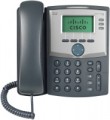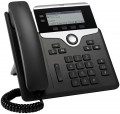VoIP protocols
VoIP voice protocols supported by the phone.
The VoIP protocol is a set of standards and rules for transmitting voice over TCP/IP networks (including the Internet). In modern IP phones, there may be such options:
—
SIP. One of the most popular protocols found in most modern IP phones. SIP is not responsible for the entire communication, but for connection management — connecting and disconnecting clients. It is distinguished by a good set of features, high speed of establishing a connection, as well as simplicity and a small amount of transmitted service information. The main disadvantage is the poor compatibility of different devices with each other. However, this applies only to additional features, and with basic features, such as establishing a connection, there are no problems usually. Due to this, SIP is being used more and more widely and is gradually replacing the H.323 standard.
—
H.323. Another popular VoIP communication protocol. Technically, the H.323 standard includes a whole set of protocols, but in this case, it is the connection management method that is meant. Compared to SIP, the additional features of H.323 are more limited, and the data format is more complex. On the other hand, this protocol has a fairly strict set of specifications, which guarantees excellent compatibility between the connected devices, even if they are from different manufacturers.
...>
— MGCP. Control protocol so-called media gateways — devices designed to convert traffic between networks of different types, in this case, between an IP network and public telephone networks (mobile or landline).
— SCCP. A protocol owned by Cisco Systems and used in its telecommunications equipment. In addition to the standard connection management features (connection/disconnection), it has a number of additional features. Note that voice communication in SCCP devices is performed through the Cisco CallManager system, which provides compatibility with other popular protocols such as SIP, H.323 and MGCP described above.
— SDP. A fairly multifunctional connection protocol that can be used not only in telephony, but also for the transfer of other types of information — video, data, control and streaming applications. It is found mainly in premium IP phones, which are distinguished by an abundance of additional features.
This list is not exhaustive, manufacturers may include other VoIP protocols in their designs.Features
—
Video camera. The presence of built-in video camera in the design of the IP-phone. This feature allows not only voice, but also video communication — of course, if the interlocutor's equipment also supports this communication format. And some models may provide the use of the camera for its traditional purpose — for photo and video shooting.
—
Skype support. Support of the popular Skype messenger by the IP phone. Skype features include not only voice, but also video communication, text messaging, as well as calls to numbers of both landline and mobile users. At the same time, this messenger uses its own communication protocols that are incompatible with popular VoIP protocols (see above). Therefore, communication with another IP phone via Skype is possible only if the other phone also supports Skype.
—
Android OS. The presence of the Android operating system on the phone. A key feature of such software is the ability to install various additional applications that may not be related to the original purpose of the device at all (for example, games). Thus, the presence of Android in an IP phone, in fact, turns it into a smartphone and allows you to significantly expand the original features of the device. Note that this feature, usually, requires a touch screen.
—
Answering machine. The presence of an answe
...ring machine in the design of the IP-telephone. This feature assumes at least support for the classic features of an answering machine — playing a greeting message and recording a voice message from the caller. In addition, extra features may be provided — for example, remote listening to messages when entering a password.
— Caller ID. The presence of caller identification feature in the IP-phone. The purpose of this feature is obvious from the name: it allows the user to see the number from which he is being called.
— Conference call. The presence of the conference feature in the phone allows you to use the device for organizing conversations simultaneously between several people. Thus, during a group conversation, the personal presence of each participant is not required — he can be connected to the conference remotely. At the same time, additional features may be provided — for example, switching to a private conversation with one of the participants. Note that the phones of the conference participants may not support conference calls — the main thing is that it is available on the organizer's phone.
— Speakerphone (speakerphone). Support of hands-free mode. In this case, the voice of the person at the other end of the line is broadcast through an external speaker, and your voice is perceived by the microphone built into the phone. This not only makes it possible to talk without holding the handset in hand, but also allows several people to participate in the conversation at the same time — the main thing is that they are close enough to the device. This feature is found quite often in modern IP phones. In conference phones (see "Type") it is generally a regular (and, usually, the only) mode of operation.
— Support of SMS messages. Ability to work with SMS — short text messages, familiar to most users on mobile phones. Thanks to this feature, you can receive and send SMS messages in the same way as it is done from a regular mobile phone (of course, if such features are supported by the network).
— Echo cancellation. The presence of an echo cancellation feature in the design of the IP phone. The features of modern communication are such that in some cases an echo may occur during a conversation — when the user, with a slight delay, hears his own voice in the speaker of the device. This is very inconvenient, so a fairly large number of modern IP devices are equipped with echo cancellation systems.
— Detection of voice activity. The presence of a system that responds to the user's voice. Due to the operation of this system, the signal transmitted by the telephone is divided into two separate modes — "speech" and "pause"; during pauses, the data transfer speed is reduced and their volume is significantly reduced. This helps to save traffic, as well as make optimal use of the communication channel, without "clogging" it with unnecessary data when there is silence on the line. The disadvantage of such systems is the occurrence of unpleasant "deaf" pauses, creating the effect of breaking the connection; however, they can be compensated by generation of comfort noise (see below).
— Generation of comfortable noise. The presence of a system that generates a quiet constant noise on the line with a timbre that is pleasant to the human ear. This noise does not interfere with conversations and is practically inaudible during them, but it is clearly visible during pauses. Actually, filling these gaps is the main task of this feature: complete silence on the line can create the feeling that the connection is broken, and in the presence of noise, this feeling does not occur.
— Web interface. Support of web interface. This feature allows you to configure the device settings through a regular computer web browser without installing any additional software and without “digging” into the phone itself: just open the service page in the browser at a specific address and all phone settings will be in front of the user. The advantages of the web interface are, firstly, accessibility from any PC or even a smartphone/tablet connected to the local network, and with appropriate settings, via the Internet; secondly, the abundance of settings and the ease of working with them.
— PoE support. Support of PoE — Power over Ethernet technology. This feature allows you to supply power to the device directly via an Ethernet network cable (see "Interfaces"), through the same interface that is used to connect to a computer network. This eliminates the need for a separate electrical connection. Note that in order to use this feature, it must be supported not only by the device itself, but also by the network device (switch or router) to which it is connected.
— NAT/NAPT support. This technology is used to convert internal IP addresses of data packets to external ones and vice versa, thus ensuring that each computer on the local network is connected to the Internet. Support for NAT/NAPT in an IP phone indicates that the device supports certain router features and can be used as an external gateway for a local network (more precisely, subnets — WAN ports are rare even in such devices).
— OpenVPN. VPN stands for "Virtual Private Network". The idea of such a network is that all computers connected to it (including via the Internet) interact as if they are inside the same "local area". This allows you to create private networks, regardless of whether all the necessary terminals are in one physical LAN or not. OpenVPN is one of the most popular (thanks to its free and open source) technologies for creating such networks.Number of telephone lines
The largest number of phone lines to which an IP phone can be connected at the same time. In fact, this is the number of calls that the device can simultaneously work with. Support of multiple telephone lines provides various additional features — switching between calls, organizing conferences (see "Features"), connecting people with each other, etc. The specific features, however, may be different — it all depends on the model.
Incoming memory
The maximum quantity of numbers of incoming calls the phone can simultaneously store in the call log. The greater the quantity of numbers, the more voluminous this log will be, the greater the period of time it can cover.
Outgoing memory
The maximum quantity of phone numbers of outgoing calls that the phone can simultaneously store in the call log. The greater the quantity of numbers, the more voluminous this log will be, the greater the period of time it can cover.
Ringtones
The number of ringtones provided by the IP phone. The more of them, the wider the choice of the user, the higher the probability of finding the best option in the list. At the same time, we note that some models allow you to download additional ringtones if you feel like it.

